861 Hits for February 2013
Albums (0) & Images (861)

jm_CarrollBrg_051999_13
As the train approaches, the drawbridge is again lowered into position. This shot shows the massive base of the bridge's mechanism.jm_CarrollBrg_051999_13
As the train approaches, the drawbridge is again lowered into
position. This shot shows the massive base of the bridge's
mechanism.

jm_CarrollBrg_051999_14
Westbound UP 1730 rolls out of the Apparel Center and onto the drawbridge. Both the Apparel Center and Merchandise Mart have plenty of security staff to guard the tracks as the train wends its way through the area.jm_CarrollBrg_051999_14
Westbound UP 1730 rolls out of the Apparel Center and onto the drawbridge. Both the Apparel Center and Merchandise Mart have plenty of security staff to guard the tracks as the train wends its way through the area.
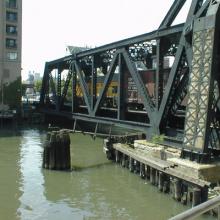
jm_CarrollBrg_051999_15
As the train heads across the bridge, we realize that this sight will soon be only a memory. Next year, a new Sun-Times printing plant opens on the South Side. The Carroll Avenue job will cease and the bridge will likely be torn down.jm_CarrollBrg_051999_15
As the train heads across the bridge, we realize that this sight will soon be only a memory. Next year, a new Sun-Times printing plant opens on the South Side. The Carroll Avenue job will cease and the bridge will likely be torn down.
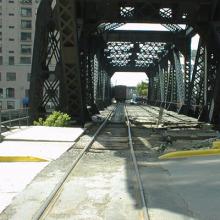
jm_CarrollBrg_051999_16
The end of the last boxcar fades in the distance. These scenes will be repeated tomorrow and for months to come...but soon these photos will be the only reminders of a very special piece of Chicago's railroad history.jm_CarrollBrg_051999_16
The end of the last boxcar fades in the distance. These scenes will
be repeated tomorrow and for months to come...but soon these photos
will be the only reminders of a very special piece of Chicago's
railroad history.
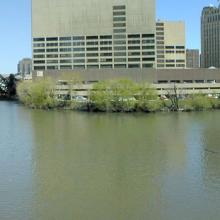
jm_Carroll_041999_01
This is one of the most beautiful scenes along the Chicago River: Wolf Point, where the North and South Branches meet in downtown Chicago. Hidden beneath the buildings in the background is a single UP / ex-CNW track that runs east to deliver newsprint to the Chicago Sun-Times. The trains cross over the drawbridge (left), travel under the Apparel Center (middle) and the Merchandise Mart (right), and then re-emerge briefly on street trackage for four blocks.jm_Carroll_041999_01
This is one of the most beautiful scenes along the Chicago River: Wolf Point, where the North and South Branches meet in downtown Chicago. Hidden beneath the buildings in the background is a single UP / ex-CNW track that runs east to deliver newsprint to the Chicago Sun-Times. The trains cross over the drawbridge (left), travel under the Apparel Center (middle) and the Merchandise Mart (right), and then re-emerge briefly on street trackage for four blocks.

jm_Carroll_041999_02
This is Carroll Avenue, looking east from Wells Street: a fascinating urban scene! Vehicles are everywhere both above and around the tracks, which are visible from overhead for 2 blocks.jm_Carroll_041999_02
This is Carroll Avenue, looking east from Wells Street: a fascinating urban scene! Vehicles are everywhere both above and around the tracks, which are visible from overhead for 2 blocks.
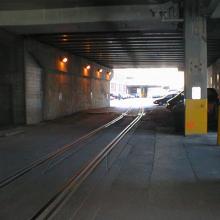
jm_Carroll_041999_03
At Clark Street, the tracks run under the Quaker Building through a service and delivery area. This view looks back west on the lower level.jm_Carroll_041999_03
At Clark Street, the tracks run under the Quaker Building through a service and delivery area. This view looks back west on the lower level.

jm_Carroll_041999_04
Two blocks farther east beneath State Street, Carroll Avenue comes to an end as we reach a switch leading to the Sun-Times spur track on the right. The tracks ahead are in hard packed dirt, and the tunnel ahead is beginning to get very dark (gulp!).jm_Carroll_041999_04
Two blocks farther east beneath State Street, Carroll Avenue comes to an end as we reach a switch leading to the Sun-Times spur track on the right. The tracks ahead are in hard packed dirt, and the tunnel ahead is beginning to get very dark (gulp!).
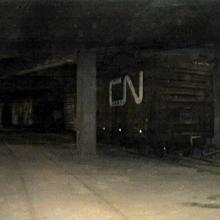
jm_Carroll_041999_05
In near total darkness, with only the light of the camera flash and a few security lights, this shot shows one of 5-6 boxcars delivering newsprint rolls to the Sun-Times Building loading docks. Note how the train crew had to break up the cars and spot them at each door. The track at the left would hold the outgoing empties while the incoming cars are spotted.jm_Carroll_041999_05
In near total darkness, with only the light of the camera flash and a few security lights, this shot shows one of 5-6 boxcars delivering newsprint rolls to the Sun-Times Building loading docks. Note how the train crew had to break up the cars and spot them at each door. The track at the left would hold the outgoing empties while the incoming cars are spotted.
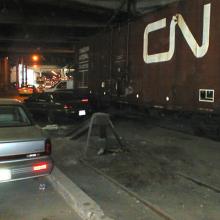
jm_Carroll_041999_06
End of the line! At Kinzie and Wabash, the rails disappear under asphalt paving. The track with the Hayes bumper used to continue to run even farther east, serving a variety of industries into the 1980's including the Chicago Tribune, the Mandel Building, a sugar syrup factory (which unloaded barges in Ogden Slip by crane!), North Pier Warehouse, and Navy Pier. Alas, even this present operation will disappear in the coming months as the new Sun-Times printing plant becomes operational.jm_Carroll_041999_06
End of the line! At Kinzie and Wabash, the rails disappear under
asphalt paving. The track with the Hayes bumper used to continue to
run even farther east, serving a variety of industries into the
1980's including the Chicago Tribune, the Mandel Building, a sugar
syrup factory (which unloaded barges in Ogden Slip by crane!),
North Pier Warehouse, and Navy Pier. Alas, even this present
operation will disappear in the coming months as the new Sun-Times
printing plant becomes operational.

jm_CNWGP7_041999_01
Since I commute to work on Chicago's Metra NW line, I occasionally see a few CNW locomotives at the downtown terminal. One lucky day, I had my camera along and got off my usual train to see this lovely sight on the adjoining track.jm_CNWGP7_041999_01
Since I commute to work on Chicago's Metra NW line, I occasionally
see a few CNW locomotives at the downtown terminal. One lucky day,
I had my camera along and got off my usual train to see this lovely
sight on the adjoining track.
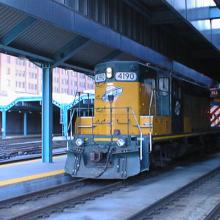
jm_CNWGP7_041999_02
Nearly 50 years old, this GP7 #4190 is still used as a "yard goat", hauling the Metra locomotive (behind) and passenger cars to the coach yard until the evening rush hour.jm_CNWGP7_041999_02
Nearly 50 years old, this GP7 #4190 is still used as a "yard goat",
hauling the Metra locomotive (behind) and passenger cars to the
coach yard until the evening rush hour.
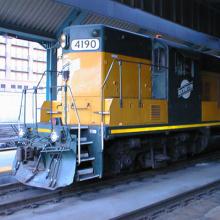
jm_CNWGP7_041999_03
Most of the familiar green and yellow Chicago and Northwestern locomotives have been scrapped, sold, or repainted since the merger with UP. That makes these photos very special, capturing a sight that will soon disappear forever.jm_CNWGP7_041999_03
Most of the familiar green and yellow Chicago and Northwestern locomotives have been scrapped, sold, or repainted since the merger with UP. That makes these photos very special, capturing a sight that will soon disappear forever.

jm_CNWGP7_041999_04
There are several GP7s used around the terminal, but most are modified versions with a lowered front nose. #4190 retains the classic high nose look. The paint job and engine look factory new!jm_CNWGP7_041999_04
There are several GP7s used around the terminal, but most are modified versions with a lowered front nose. #4190 retains the classic high nose look. The paint job and engine look factory new!

jm_CNWGP7_041999_05
This profile view shows the cab and the side vents that distinguish the GP7 from the GP9. In fact, if you look to the lower right of the CNW logo, "GP7" is lettered right on the cab.jm_CNWGP7_041999_05
This profile view shows the cab and the side vents that distinguish
the GP7 from the GP9. In fact, if you look to the lower right of
the CNW logo, "GP7" is lettered right on the cab.
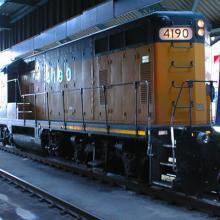
jm_CNWGP7_041999_06
The rear view of #4190 captures the soft glow of the headlights and number boards and the flash's reflection off the safety stripes on the sides and steps. Note the slightly crooked handrail stanchions; I guess my HO model is prototypical after all! :-)jm_CNWGP7_041999_06
The rear view of #4190 captures the soft glow of the headlights and
number boards and the flash's reflection off the safety stripes on
the sides and steps. Note the slightly crooked handrail stanchions;
I guess my HO model is prototypical after all! :-)